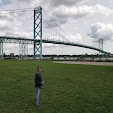Near the mouth of the Mississippi River, the village of Pointe à la Hache (pronounced like “Point la Hatch”) is the
southernmost permanent community on the east bank of the Mississippi River, located
about 50 miles upriver from the Head of Passes Light, the official mouth of the
river at the end of the delta. This community, which has been the parish seat
of Plaquemines Parish since the parish’s establishment in 1807, has a
population of less than 200, yet is also home to the southernmost public
vehicle crossing on the river. This ferry service has operated commercially in
this location since 1933 and like its neighboring ferries
upriver, this crossing requires the payment of a toll and ferries depart from
each landing every 30 minutes on most days.
The eastern ferry landing leads to the southern
reaches of LA Highway 39, which follows the east bank of the river northward
toward St. Bernard Parish and greater New Orleans. The western ferry landing
leads to LA Highway 23 (sometimes known as Belle Chasse Highway), which follows
the west bank of the river northward toward greater New Orleans and southward
toward Venice and the mouth of the Mississippi River. Due to its isolated
location over an hour’s drive downriver from greater New Orleans, this is the
lightest-trafficked of the ferry services on the Mississippi River in
Louisiana. The population of Plaquemines Parish on the east bank of the river
was reduced to a hardy few following the devastation brought to the area by
Hurricane Katrina in 2005. As a result of the lack of population on that side
of the river since then, traffic counts on this ferry crossing have been
drastically lower over the last 20 years than in the years leading up to 2005.
Since 2013, the ferry has been closed to heavier commercial vehicles, meaning that any such traffic must utilize the ferries closer to the city or even divert to the Crescent City Connection. All in all and in spite of the lack of vehicle traffic, this is a quintessentially Louisianan experience for folks who enjoy an old-fashioned, isolated transportation experience near the mouth of one of America’s great rivers.
The following pictures were taken during my westbound crossing of the Pointe à la Hache Ferry in January 2017. Click on each photo to see a larger version.
Dashcam video of the eastbound trip over the Pointe à la Hache Ferry was filmed in January 2017 for the 'roadwaywiz' YouTube channel and is available for viewing at the link below:
How To Get There:
Bridges, Crossings, and Structures of the Lower Mississippi River
Next Crossing upriver: Belle Chasse-Scarsdale Ferry (Belle Chasse, LA)
Next Crossing downriver: Mouth of the Mississippi River
Return to the Bridges of the Lower Mississippi River Home Page
__________________________________________________































Comments